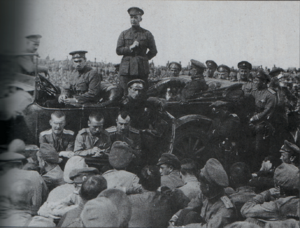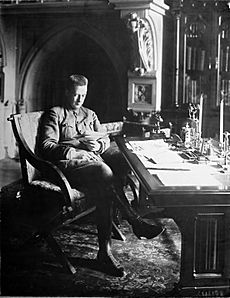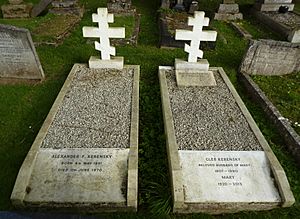Alexander Kerensky facts for kids
Quick facts for kids
Alexander Kerensky
|
|
|---|---|
| Александр Керенский | |

Kerensky in 1917
|
|
| Minister-President of the Russian Republic | |
| In office 14 September 1917 – 7 November 1917 [1 September – 25 October 1917 Old Style] |
|
| Succeeded by | Office abolished |
| Minister-Chairman of the Russian Provisional Government | |
| In office 21 July 1917 – 14 September 1917 [8 July – 1 September 1917 Old Style] |
|
| Preceded by | Georgy Lvov |
| Succeeded by | Himself |
| Minister of War and Navy | |
| In office 18 May 1917 – 14 September 1917 [5 May – 1 September 1917 Old Style] |
|
| Minister-Chairman | Georgy Lvov Himself |
| Preceded by | Alexander Guchkov |
| Succeeded by | Aleksander Verkhovsky (Minister of War) Dmitry Verderevsky (Minister of Navy) |
| Minister of Justice | |
| In office 16 March 1917 – 1 May 1917 [3 March – 18 April 1917 Old Style] |
|
| Minister-Chairman | Georgy Lvov |
| Preceded by | Position established |
| Succeeded by | Pavel Pereverzev |
| Personal details | |
| Born |
Alexander Fyodorovich Kerensky
4 May 1881 Simbirsk, Simbirsk Governorate, Russian Empire |
| Died | 11 June 1970 (aged 89) New York City, U.S. |
| Resting place | Putney Vale Cemetery, London |
| Nationality | Russian |
| Political party | Socialist Revolutionary (Trudovik Parliamentary breakaway group) |
| Children |
|
| Alma mater | Saint Petersburg State University |
| Profession | |
| Signature | |
Alexander Fyodorovich Kerensky (born May 4, 1881 – died June 11, 1970) was a Russian lawyer and revolutionary. He became a very important leader in Russia during a time of big changes. He led the Russian Provisional Government and the short-lived Russian Republic for about three months in 1917.
After the February Revolution in 1917, Kerensky joined the new government. He started as the Minister of Justice, then became the Minister of War. Later, in July, he became the Minister-Chairman, which is like a prime minister. He was a leader of a group called the Trudoviks, which was part of the Socialist Revolutionary Party. Kerensky was also a vice-chairman of the Petrograd Soviet, a powerful group of workers and soldiers.
As prime minister, Kerensky faced the challenge of World War I. Many people in Russia wanted to stop fighting, but Kerensky decided to continue Russia's part in the war. His government tried to stop people from protesting the war, which made them even less popular.
Kerensky stayed in power until the October Revolution. In this revolution, a group called the Bolsheviks, led by Vladimir Lenin, took over his government. Kerensky had to leave Russia and lived the rest of his life in other countries, mainly in Paris and New York City. He also worked at the Hoover Institution at Stanford University.
Contents
Biography
Early Life and Education
Alexander Kerensky was born in Simbirsk (now called Ulyanovsk) in Russia on May 4, 1881. He was the oldest son in his family. His father, Fyodor Mikhailovich Kerensky, was a teacher and later became an inspector of public schools. Alexander's family was friends with the family of Vladimir Lenin, who would later become a major leader of the Bolsheviks.
In 1889, when Alexander was eight, his family moved to Tashkent. He finished school with honors in 1899. That same year, he started studying history and languages at St. Petersburg University. The next year, he changed his studies to law. He finished his law degree in 1904.
Early Career and Politics
After becoming a lawyer, Kerensky became known for defending revolutionaries in political trials. In 1912, he became even more famous when he visited the gold mines at the Lena River. He wrote about the terrible conditions there, which was called the Lena Minefields incident.
In the same year, Kerensky was chosen to be a member of the Fourth Duma. The Duma was like Russia's parliament. He was part of the Trudoviks, a socialist group. He also joined a secret society called the Grand Orient of Russia's Peoples, which wanted to bring democracy to Russia and end the rule of the Tsar. Kerensky was a great speaker and a strong leader against the government of Tsar Nicholas II.
During World War I, Kerensky spoke out about the need for the Tsar to make changes. He asked for things like freedom for political prisoners and more rights for different groups of people in Russia.
The Russian Provisional Government of 1917
When the February Revolution happened in 1917, Kerensky was one of the most important leaders. He was a strong voice against the monarchy. He became a member of the Provisional Committee of the State Duma and was chosen as vice-chairman of the new Petrograd Soviet. These two groups, the Duma and the Petrograd Soviet, often disagreed.
The Petrograd Soviet grew very large, with thousands of members. Kerensky was the only person who was part of both the Provisional Government and the Petrograd Soviet. This made him a key link between the two groups.
One important decision by the Petrograd Soviet was Order No. 1. This order told soldiers to form their own committees and reduced the power of officers. This caused a lot of confusion in the army. Kerensky's exact role in this order is not fully clear. However, he often helped protect government officials who were in danger from angry crowds.
After some political problems in May, Kerensky became the Minister of War. He became a very important figure in the new government. He traveled to the war front, giving speeches to encourage soldiers to keep fighting.
On 1 July [O.S. 18 June] 1917, Kerensky launched a major attack against the Austro-Hungarian and German armies. This was known as the Kerensky Offensive. At first, it was successful, but then the enemy fought back strongly. The Russian army suffered heavy losses and many soldiers left. It became clear that the army no longer wanted to fight.
Many military leaders criticized Kerensky. They disliked his policies, such as taking away power from officers and allowing revolutionary speakers at the front.
On July 2, 1917, the government faced another crisis. After protests in Petrograd, Kerensky took over from Prince Lvov and became Russia's Prime Minister on 21 July [O.S. 8 July] 1917. Later, after an attempted military takeover called the Kornilov Affair, Kerensky also made himself the Supreme Commander-in-Chief of the army.
On September 15, Kerensky declared Russia a republic. This was a big step, as many believed the form of government should be decided by a special assembly later. He formed a small group of five leaders to run the country. He stayed in his role until the Bolsheviks overthrew his government on 7 November [O.S. 26 October] 1917.
Kerensky faced huge challenges. Russia had been fighting in World War I for three years and was very tired. The government struggled to motivate people to continue fighting. Many people, especially soldiers, thought the war would end when the new government took power. They felt tricked when it continued. Meanwhile, Vladimir Lenin and his Bolshevik party promised "peace, land, and bread" to the people. The Russian army was falling apart, with many soldiers leaving. By late 1917, about two million men had left the army.
Kerensky and other leaders believed that winning the war was the only way forward for Russia. They also worried that stopping the war would hurt the economy even more. This was a very difficult decision. Kerensky's changing policies made the army and the country even more unstable.
Kerensky also made a mistake by isolating conservative groups. His idea of "no enemies to the left" gave a lot of power to the Bolsheviks. They were able to gain control of the military groups in Petrograd and Moscow. When Kerensky arrested some officers, he lost strong allies who could have helped him against the Bolsheviks. The Bolsheviks became his strongest enemies.
The October Revolution of 1917
During the Kornilov Affair, Kerensky had given weapons to the workers in Petrograd. By November, most of these armed workers had joined the Bolsheviks. On 6–7 November [O.S. 25–26 October] 1917, the Bolsheviks started the second Russian revolution of the year. Kerensky's government in Petrograd had almost no support. Only a small group of women soldiers, known as The Women's Death Battalion, tried to fight for the government. But they were quickly defeated by the larger Bolshevik forces. The Bolsheviks took over government buildings and the Winter Palace very quickly.
Kerensky managed to escape the Bolsheviks and went to Pskov. There, he gathered some loyal troops to try and take back the city. His troops captured a town called Tsarskoye Selo but were defeated the next day. Kerensky barely escaped and spent weeks hiding before leaving Russia. He eventually arrived in France. During the Russian Civil War that followed, he did not support either side, as he was against both the Bolsheviks and the groups fighting against them.
Later Life and Death
Alexander Kerensky was married to Olga Lvovna Baranovskaya, and they had two sons, Oleg and Gleb, who both became engineers. Kerensky and Olga divorced in 1939. In the same year, he met and married Lydia Ellen "Nell" Tritton, an Australian journalist who worked for him.
When Germany invaded France in 1940, Kerensky and Nell moved to the United States. After Germany attacked the Soviet Union in 1941, Kerensky offered his help to Joseph Stalin, the Soviet leader. In 1945, when his wife Nell became very ill, Kerensky traveled with her to Australia to be with her family. She passed away in 1946. Kerensky then returned to the United States.
Kerensky lived in New York City for the rest of his life. He spent a lot of time at the Hoover Institution at Stanford University in California. There, he used and added to a large collection of documents about Russian history. He also taught classes and wrote many books and articles about Russian politics and history. His last public talk was in October 1967.
Alexander Kerensky died in New York City on June 11, 1970, at the age of 89. He was one of the last major people from the big events of 1917 still alive. Local Russian Orthodox Churches in New York City refused to bury him. This was because of his connection to Freemasonry and because they blamed him for the Bolsheviks taking power. So, Kerensky's body was flown to London, England, where he was buried in Putney Vale Cemetery.
Works
- The Prelude to Bolshevism (1919)
- The Catastrophe (1927)
- The Crucifixion of Liberty (1934)
- Russia and History's Turning Point (1965)
- Memoirs (1966)
See also
 In Spanish: Aleksandr Kérenski para niños
In Spanish: Aleksandr Kérenski para niños
- Jailbirds of Kerensky
Images for kids






